Flamingo dads are flamtastic!
Flamingo dads are some of the most hardworking and devoted of parents in the animal kingdom. Find out why in this Flamingo Diary post!
June is the month of Father’s Day in the UK (and in some other countries around the world too) and therefore it’s a good time to look at the flamingo dad’s role in parenting the next generation of pink birds. Flamingo fathers take on half of the responsibilities of nesting and chick care, showing the strength of the pair bond that exists between a male and female bird. Flamingo dads meet flamingo mums during group courtship dancing. Like young love across the dance floor of the school disco, flamingo dad and flamingo mum first find that spark of attraction at a social mixer.
The majority of partnerships in a nesting colony are stable male and female pairings. But flamingo society is complex and there are incidences of multiple partnerships and extra martial liaisons involving both male and female birds, but this is a family show… We’re still unsure of the exact choice being made, but the biggest, brightest pink flamingo dads are the most attractive to prospective flamingo mums. Recent scientific research has shown that female flamingos invest a lot of energy in producing the brightest pink plumage as they need to attract an equally good quality partner to produce the strongest, healthiest chick.
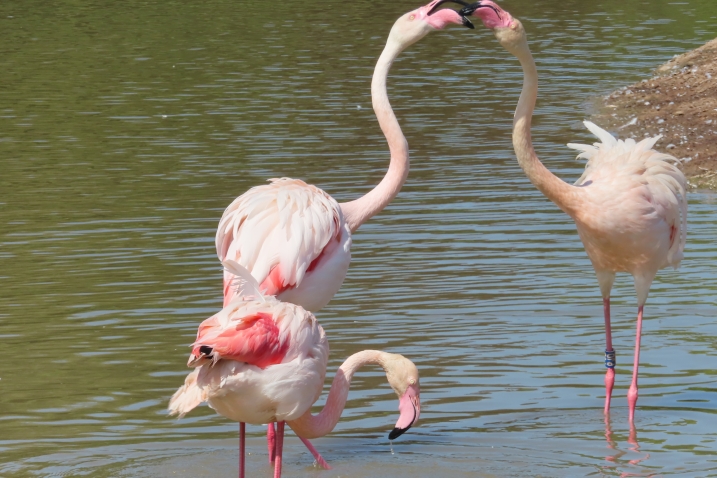
A male greater flamingo (back left) drives away an intruding male (right) who was keen to "get acquainted" with his female partner (front left).
This strong partnership is important. Raising a flamingo chick is hard work. The wetlands that flamingos reside in can be inhospitable places. Prone to flooding one moment and baking heat and drought the next. Nesting sites may have limited food resources, meaning parent flamingos have to travel between feeding and nesting lakes. Therefore, to cope with the environment, the weather and the location, mum and dad flamingo stick together and share responsibilities to give their chick the best start in life. Wild flamingos can live into their ‘50s and potentially ‘60s. Birds may not breed every year, with some estimates suggesting that only a fifth of adults capable of breeding will do so each year. Therefore, across this vast lifespan, a flamingo may only be a parent a handful of times. So when they do breed, it pays for flamingo dads and mums to be completely committed to their parental duties!
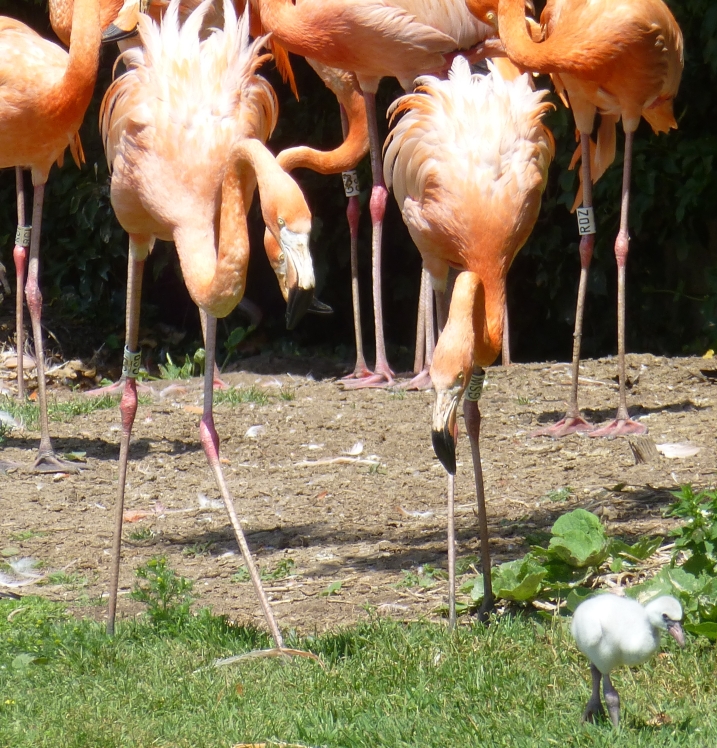
Dad and mum take baby for a wander. Caribbean flamingo parents keep a close eye on their chick who goes for a walk around the colony.
Flamingo dads are keen nest builders. They will start making the original scrape in mud or sand that will become the nest mound with the female but as it develops, more effort is put in by the female bird. But once an egg is laid, the male’s efforts redouble, and he keeps constructing a higher and higher nest mound as a way of keeping the egg and eventual chick clear of flash flooding. Incubation is shared by both parents. The duty of sitting on the egg and keeping it warm is something that flamingo fathers take very seriously. Although just after laying, the female flamingo tends to do more incubation, over the course of the month-long incubation period, research has shown that flamingo dads spend significantly more time at the nest, and on the nest incubating the egg. The male flamingo is also the more aggressive member of the pair; driving away neighbouring birds from his nest and helping to protect the nest, his partner and egg from intruders.
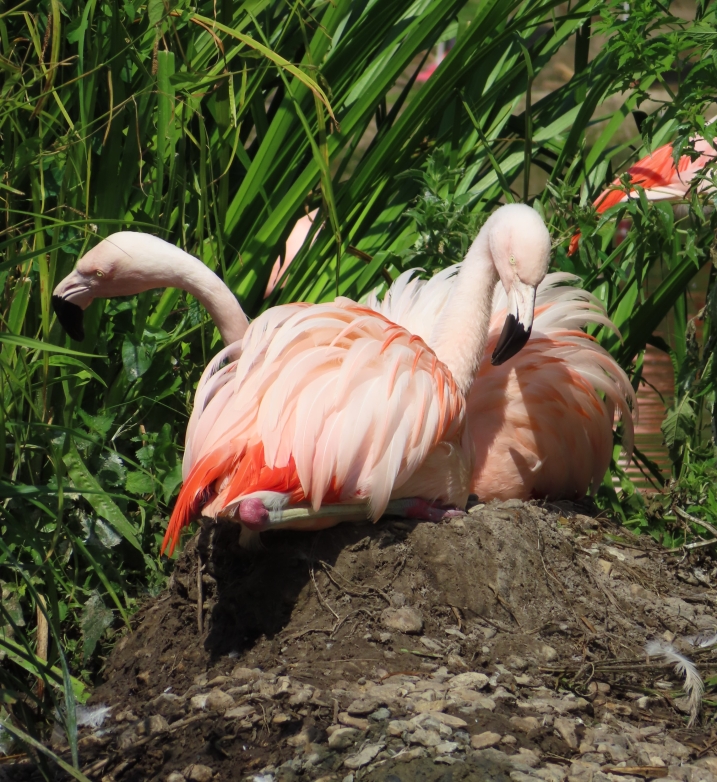
Keen on construction. Flamingo dads are the ones responsible for the height of a nest mound.
Once a chick hatches, flamingo dads and flamingo mums take turns in sheltering the chick, keeping it warm and in feeding it. Flamingo parents perform a special foot shaking action when they climb back onto their nest mound. This prevents mud or water from coating the egg or newly hatched young. Interestingly, flamingo dads will foot shake when climbing onto their nest mound even before the egg is laid, but flamingo mums only foot shake once they have laid their egg. Clearly female flamingos know when to start this behaviour and when its not needed!
Flamingos use their unique filter feeding technique to stop their nest mound from flooding. If any rainwater enters the bowl at the top of the nest mound, the flamingo dad and flamingo mum will pump this water into their bill using their tongue, and then dribble it over the side of the nest mound. Young flamingo chicks are fluffy and grey; they are not fully waterproof until they grow their first set of brown juvenile feathers. Like ducklings and goslings, they rely on protection from their parents to stay warm and dry. The cold is a real danger to young flamingos. In the high Andes of South America, sudden freezing conditions can occur and if a parent is not near its nest to provide the chick with shelter, things can go downhill rapidly.
Flamingo chicks are dependent on their parents for a long time. Chicks need to be fed until the specialised filtering apparatus is fully developed within their bills and they are able to fly to different wetlands in search of food. Feeding ends around 70 days (3 months) of age but can continue for longer if needed. Flamingo dads produce crop milk, the secretion from glands in their oesophagus, in the same way as flamingo mums do. This crop milk is high in fat and protein, and the chick grows quickly on such a high energy, nutrient dense diet. Research shows that lesser flamingo chicks can be nearly 1.5kg in weight by only 60 days of age. Chicks need to grow quickly to moult into juvenile feathers that can allow for flight so that youngsters can leave nesting areas and travel to other wetlands where food is more readily available.
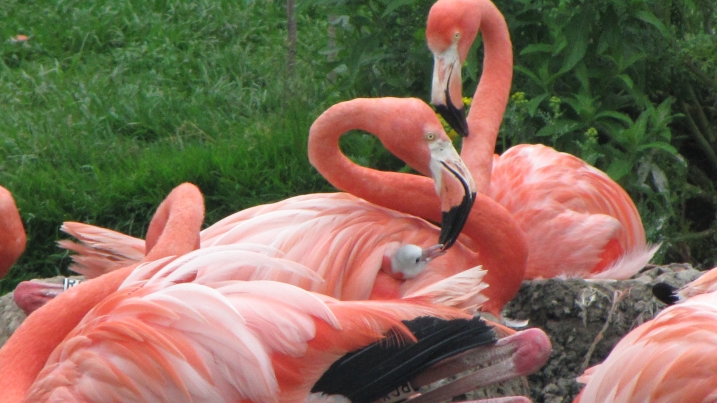
A newly hatched Caribbean flamingo chick being fed by its father.
The volume of crop milk needed to raise a chick to fledging in a relatively short period of time drains a parent flamingo of its colour. Flamingo dads and flamingo mums will be pale pink to almost white by the end of the nesting period. Once baby has flown the coop, they relax, moult new feathers and get back into their fancy pink dress ready for the next opportunity for courtship dancing and flamingo romance.
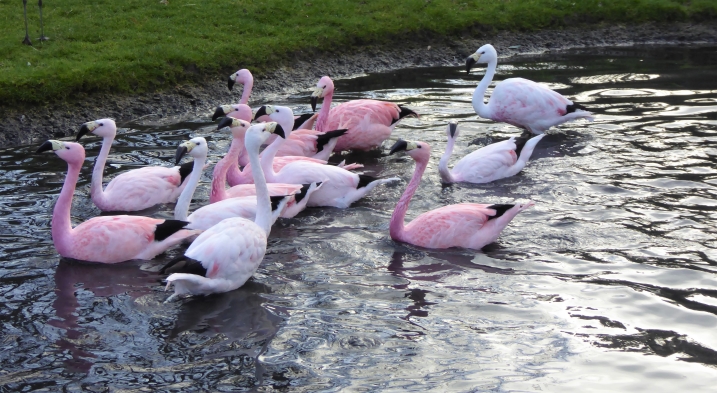
Spot the parents! Or in this case, foster parents. The white Andean flamingos in this photo were foster parents to Chilean flamingo chicks and the efforts of crop milk production causes them to lose their pink colour. Don't worry, it will come back!
WWT Martin Mere has had a bumper crop of greater flamingo chicks this summer. And lots of attentive parents can be seen tending to the needs of their offspring. Spare a thought for these hard working dads and mums on your next visit to a WWT flamingo flock. And a very happy Father's Day to all of the human and avian fathers, grandfathers and father-figures out there!



